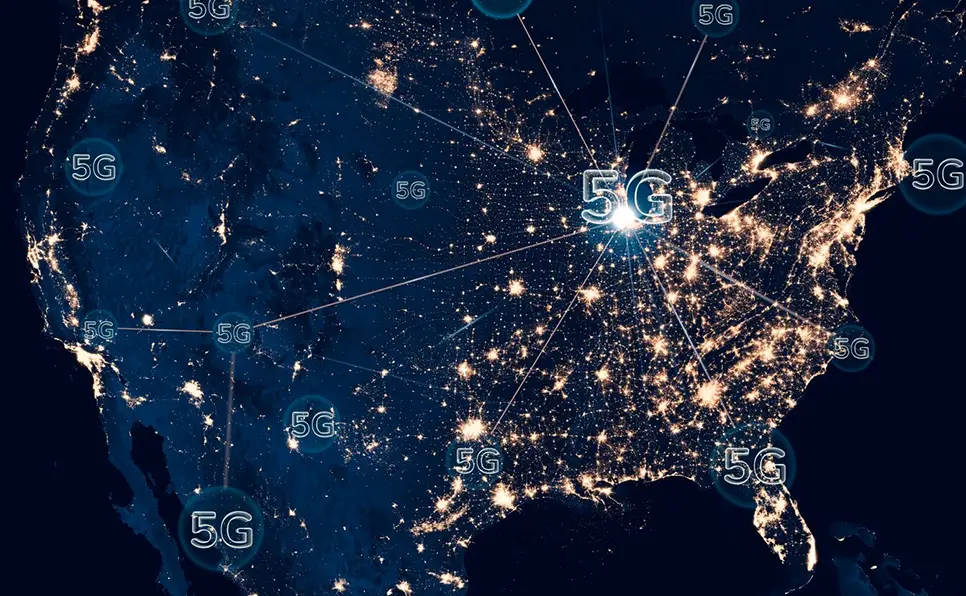5G, or fifth generation, wireless technology is the latest and greatest in mobile network technology. It promises to revolutionize the way we communicate, work, and live. With its lightning-fast speeds, ultra-low latency, and increased capacity, 5G has the potential to change the way we interact with technology and the world around us.
What is a 5G Network Technology?
5G is the fifth generation of mobile networks, following 4G, 3G, and 2G. It is a new type of wireless technology that promises to offer faster speeds, lower latency, and increased capacity compared to previous generations of mobile networks.
5G networks are designed to support a wide range of new use cases, including virtual reality, augmented reality, the Internet of Things (IoT), and other emerging technologies. This will enable new business models and create opportunities for innovation in various sectors.
5G networks are designed to be more energy efficient than 4G networks, which will make them more sustainable in the long run and reduce the environmental impact of mobile networks. Networks are also designed to support a higher level of reliability than 4G networks, which will make them suitable for mission-critical applications such as self-driving cars, remote surgery, and industrial automation.
5G networks work by using a combination of different types of spectrum, including high-frequency millimeter wave spectrum and lower-frequency sub-6GHz spectrum, which allows for better coverage and penetration in buildings and other hard-to-reach areas.
Overall, 5G technology is a new generation of mobile networks that promises to revolutionize the way we communicate and interact with technology, providing faster, more reliable, and more efficient wireless connections for a wide range of devices and applications.
Features, Benefits, and Advantages of 5G Network Technology:
One of the key features of 5G is its impressive speed. While 4G networks typically max out at around 100Mbps, 5G networks can reach speeds of up to 10Gbps. This means that 5G networks can download an entire HD movie in just a few seconds, compared to several minutes on a 4G network. This increased speed will have a huge impact on how we use our mobile devices, allowing us to stream high-definition videos, play online games, and download large files with ease.
Another major advantage of 5G is its ultra-low latency. Latency is the time it takes for a device to send a signal to the network and receive a response. On 4G networks, latency is typically around 50 milliseconds, but 5G networks can have latency as low as 1 millisecond. This ultra-low latency will enable new use cases such as remote surgery, autonomous vehicles, and industrial automation.
In addition to speed and latency, 5G networks also offer increased capacity. This means that more devices can connect to the network at the same time without any loss of speed or performance. This is especially important as the number of connected devices continues to grow. According to a study by Ericsson, there will be around 29 billion connected devices by 2024. With 5G, we will have the capacity to oversee this influx of devices without any issues.
Some additional Benefits:
- Improved coverage: 5G networks use a combination of high- and low-frequency spectra, which allows for better coverage and penetration in buildings and other hard-to-reach areas. This means that 5G networks will be able to reach more people in more places than 4G networks.
- More efficient use of spectrum: 5G networks use a technique called “massive MIMO” (multiple input, multiple outputs) which allows for more efficient use of spectrum. This means that more data can be transmitted in the same amount of spectrum, which will increase capacity and reduce congestion on the network.
- Support for new use cases: 5G networks are designed to support a wide range of new use cases such as virtual reality, augmented reality, and the Internet of Things (IoT). This will enable new business models and create opportunities for innovation in various sectors.
- Improved reliability: 5G networks are designed to have a higher level of reliability than 4G networks, which will make them suitable for mission-critical applications such as self-driving cars, remote surgery, and industrial automation.
- Increased energy efficiency: 5G networks are designed to be more energy efficient than 4G networks. This will make them more sustainable eventually and reduce the environmental impact of mobile networks.
- Advanced Network slicing: 5G networks will allow for advanced network slicing, which enables network providers to create multiple virtual networks that can be tailored to specific use cases. This will allow for more efficient use of network resources and enable new business models.
How did 5G Network Technology evolve?
The evolution of 5G network technology can be traced back to the early days of mobile communication. The first generation (1G) of mobile networks was introduced in the 1980s and primarily focused on voice communication. The second generation (2G) of mobile networks, introduced in the 1990s, introduced the concept of digital communication and data services such as text messaging. The third generation (3G) of mobile networks, introduced in the 2000s, brought significant improvements in data speeds and the ability to access the internet on mobile devices. The fourth generation (4G) of mobile networks, introduced in the 2010s, brought even faster data speeds and the ability to support more devices and applications.
The development of the 5G network technology began in the early 2010s, with the goal of addressing the limitations of existing 4G networks and meeting the growing demand for mobile data. 5G networks are designed to provide faster download and upload speeds, lower latency, and increased capacity for connected devices. This is achieved through the use of higher frequency spectrum bands, advanced modulation techniques, and the deployment of small cells and other types of infrastructure.
The 5G standardization process has been ongoing for several years, and the first commercial 5G networks were launched in 2019. Since then, the deployment of 5G networks has been gaining momentum globally, and it is expected that 5G will become the dominant mobile network technology in the coming years.
The evolution of 5G network technology has been a collaborative effort involving industry leaders, academic researchers, and government agencies. Standardization bodies such as the 3rd Generation Partnership Project (3GPP) has played a critical role in coordinating the development and deployment of 5G networks. The technology is expected to continue to evolve and improve in the coming years, with the development of new technologies such as edge computing and network slicing, which will enable new use cases and applications.
How does 5G Network Technology work?
5G networks work by using a combination of different types of spectrums, including high-frequency millimeter wave spectrum and lower-frequency sub-6GHz spectrum.
High-frequency millimeter wave spectrum: 5G networks use millimeter wave spectrum, which operates in the 30GHz to 300GHz frequency range. This spectrum can support extremely high data rates, but it has a limited range and is easily blocked by physical obstacles such as buildings.
Lower frequency sub-6GHz spectrum: 5G networks also use a sub-6GHz spectrum, which operates in the 600MHz to 6GHz frequency range. This spectrum has a longer range and better penetration than the millimeter wave spectrum, but it is not able to support the same high data rates.
5G networks use a technique called beamforming to focus the millimeter wave signal to specific areas, which increases its range. Beamforming uses multiple antennas to transmit the signal in a specific direction. This allows the network to focus the signal on the device that is requesting it, which increases the capacity of the network.
5G networks also use a technique called Massive MIMO (multiple input, multiple outputs) which allows for more efficient use of spectrum. Massive MIMO uses a large number of antennas to transmit and receive signals, which increases the capacity of the network.
5G networks also use advanced Network slicing which enables network providers to create multiple virtual networks that can be tailored to specific use cases. This allows for more efficient use of network resources and enables new business models.
In addition, 5G networks use a new protocol called 5G NR (New Radio) which is designed to work with the diverse range of the spectrum that 5G networks use. 5G NR allows the network to switch between different types of spectrums depending on the needs of the devices that are connected to it.
All these techniques, protocols, and technologies work together to provide the high-speed, low-latency and increased capacity that 5G networks offer. The roll-out of 5G networks has already begun in many countries around the world. According to the GSM Association, 5G networks were live in around 60 countries by the end of 2020. The United States, South Korea, and China were among the first countries to launch 5G networks. According to a study by OpenSignal, the average 5G download speed in the United States is around 350Mbps. While this is still slower than the maximum speeds promised by 5G, it is a significant improvement over 4G speeds.
Statistics and facts about 5G network technology:
- Speed: 5G networks are expected to offer download speeds of up to 20 Gbps, which is 20 times faster than 4G networks. This means that you will be able to download a full-length HD movie in seconds.
- Latency: 5G networks are expected to have latency as low as 1 ms, which is 10 times lower than 4G networks. This means that there will be a little delay when sending and receiving data over the network.
- Capacity: 5G networks are expected to have a capacity that is 100 times greater than 4G networks. This means that more devices will be able to connect to the network at the same time without experiencing any congestion.
- Coverage: 5G networks are expected to have coverage that is 4 times greater than 4G networks. This means that more people will be able to access the network in more places than before.
- Economic impact: According to a report by Ericsson, 5G networks are expected to generate an economic impact of $3.5 trillion by 2035.
- IoT: 5G networks are expected to support up to 1 million connected devices per square kilometer, which is 100 times more than 4G networks. This will enable the growth of IoT and smart cities.
- Use cases: 5G networks are expected to support a wide range of new use cases, including virtual reality, augmented reality, self-driving cars, remote surgery, and industrial automation.
- Adoption: According to a report by IHS Markit, it is expected that by 2025, 1.9 billion 5G connections will be in use worldwide.
- Investment: According to a report by GSMA, investment in 5G networks is expected to reach $1.3 trillion by 2026.
- Spectrum: According to a report by 5G Americas, over 60 countries have allocated or auctioned spectrum for 5G services.
Disadvantages of 5G Network Technology
While 5G networks have the potential to revolutionize the way we communicate and interact with technology, there are also some concerns about 5G technology. One of the main concerns is security. As 5G networks will be used to control critical infrastructure such as power grids and transportation systems, it is important to ensure that they are secure from cyber threats. Another concern is that 5G networks will require a significant amount of spectrum to operate. This could lead to a shortage of spectrum for other uses such as satellite communications.
These are some of the potential disadvantages of 5G network technology, but it is important to note that many of these issues are being addressed by the industry and solutions are being developed to mitigate these challenges.
- Cost: One of the main disadvantages of 5G networks is that they can be expensive to deploy. Building a 5G network requires a significant investment in new infrastructure, including the deployment of new base stations and antennas. This cost can be passed on to consumers in the form of higher mobile service fees.
- Interference: 5G networks operate on high-frequency spectrum bands, which are more susceptible to interference from physical objects such as buildings and trees. This can make it more difficult to provide consistent and reliable coverage in urban areas.
- Limited coverage: Initially, the 5G coverage will be limited, only available in certain areas, and not all devices will support 5G, this may cause inconvenience for the users.
- Security: As with any new technology, there are security concerns with 5G networks. The increased use of IoT devices connected to 5G networks could make it easier for hackers to gain access to sensitive information.
- Health concerns: There have been some concerns about the potential health risks associated with the use of 5G networks, but these concerns are not well-founded, and scientific research has not found any evidence that 5G poses a health risk.
- Dependency: As 5G becomes more widely adopted, it will become more critical infrastructure, and the dependency on the network will increase. If the network were to go down, it could have a significant impact on businesses and individuals.
- Regulation and standardization: The 5G standardization process is still ongoing, and not all countries have the same regulations, this could create compatibility issues and difficulties for global communication and collaboration.
Conclusion:
5G network technology is a significant advancement in mobile communication that promises to bring faster speeds, lower latency, and increased capacity for connected devices. This new technology has the potential to enable new business models, create opportunities for innovation in various sectors, and bring economic benefits. However, there are also potential challenges associated with the deployment and use of 5G networks, such as cost, interference, limited coverage, security, and health concerns. These challenges are being addressed by the industry, and solutions are being developed to mitigate them. The 5G standardization process is still ongoing, countries need to have similar regulations to avoid compatibility issues and difficulties in global communication and collaboration. Overall, it is clear that 5G network technology is poised to play a transformative role in the future of mobile communication and the global economy.



